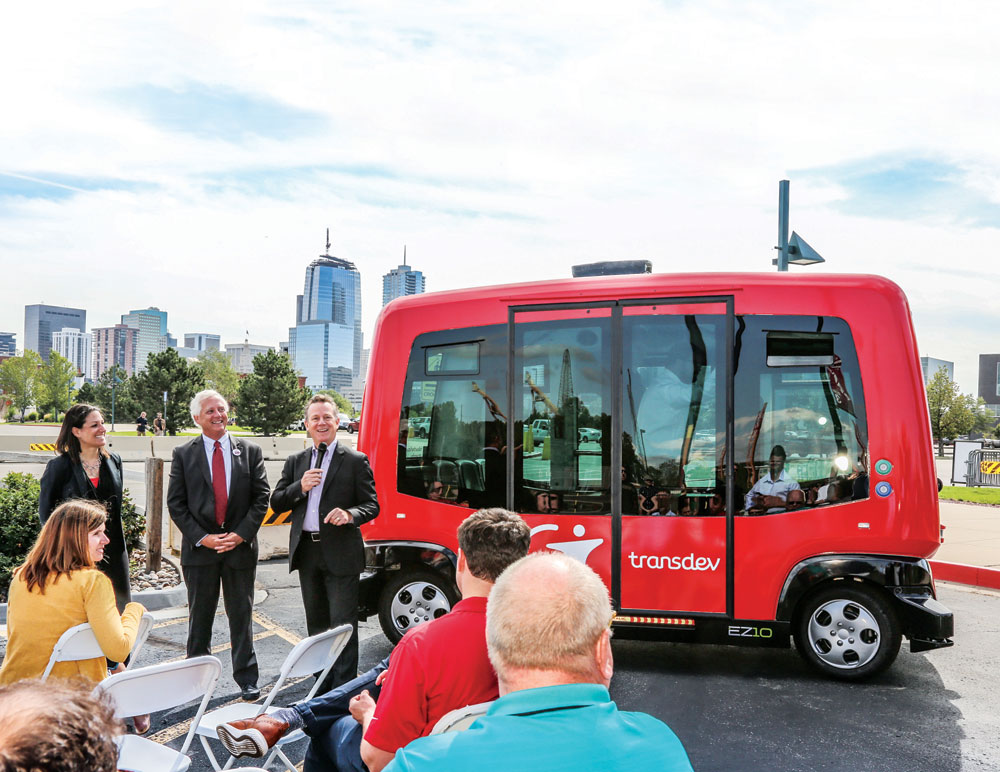
At a media event in the Pepsi Center parking lot on August 16, RTD General Manager Dave Genova (with mike) and members of the public took a ride in the EZ10 driverless vehicle. EasyMile, the French company that developed the software that runs the vehicle, is opening its North American headquarters in the Panasonic building at 61st and Peña.
A 382-acre plot of prairie along Peña Blvd. has, over the past couple of years, become a hotbed of cutting-edge technology that could become part of our lives in the not-too-distant future. At Peña Station NEXT (located at 61st and Peña Blvd.), Panasonic Enterprise Solutions has built an operations and technology center that is testing “what’s next”—technologies that can improve the livability and sustainability of cities.
“Smart city” technologies already in place at Peña Station NEXT include:
- Solar photo-voltaic panels on the Panasonic building and over the DIA parking lot
- A micro-grid featuring an industrial scale battery system being tested by Xcel (described in the May Front Porch*)
- Electric vehicle charging stations
- Interactive digital signage that allows users to get information about their public transit options, nearby services and for connecting with public safety officials in case of an emergency
- Two kinds of environmental sensors—one set embedded in the roadway and giving sub-surface and surface temperature and conditions (dry, wet, ice, etc.), and the Argonne Array of Things, which is mounted to a streetlight pole and measures a dozen variables including various air quality parameters
Driverless Vehicles:
The French-based high-tech startup Easy Mile is opening its North American headquarters inside the Panasonic building at Peña Station NEXT. This company produces the software that powers autonomic electric vehicles. Their “marquee” product is the EZ10, a 12-person driverless electric vehicle (EV) built by Ligier, Europe’s largest manufacturer of lightweight electric vehicles. This vehicle is currently deployed in 17 countries around the world and is seen as particularly useful for getting people to and from train and bus transit stations to nearby businesses and residences. Forest City has said this kind of vehicle (often referred to as a “first mile/last mile” shuttle) would be very useful at Central Park station, where transit-oriented development is about to get underway.

Riders try out the EZ10 driverless shuttle in the Pepsi Center parking lot.
Denver has the right “eco-system” to support a new technology such as the EZ 10, says transportation engineer Lauren Isaac who will work for EasyMile at Peña Station NEXT. She cites the Colorado Legislature’s passage of Senate Bill 213 in the past session, explaining that the bill creates a “permissible” regulatory environment for testing and deploying driverless vehicles.
Future Plans—A Carbon-Neutral Energy District:
At the end of July, Panasonic, Xcel and the National Renewable Energy Laboratory (NREL) announced a study to determine how to turn the 382-acre site into a “carbon neutral energy district.” The goal is to “fully offset the district’s climate impact due to electricity generation and consumption” by leveraging a wide set of technologies (e.g., more solar PV, battery energy storage, EV charging, and potentially district heating and cooling). This would be in addition to a goal of being “net-zero” in terms of energy consumption. Peter Bronski with Panasonic says the six-month study will provide a blueprint to guide development over the next 20 years in such a way that carbon neutrality is achieved on-site. “It’s also about energy resilience, innovation and making Peña Station NEXT the kind of smart, sustainable, connected development that today’s tenants are seeking.”
History:
Just a few years ago, Peña Station NEXT was referred to as the “ghost station” along the A Line commuter rail to DIA. “Ghost” because there was no funding for the station, only engineering and environmental approvals for the additional stop. Today, the station, built by developer L.C. Fulenwider, Inc. with funds from a public/private partnership, is offering a glimpse of what more livable, sustainable cites of the future could look like.
Autonomous from Steve Larson on Vimeo.


0 Comments